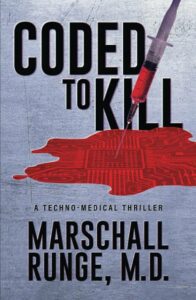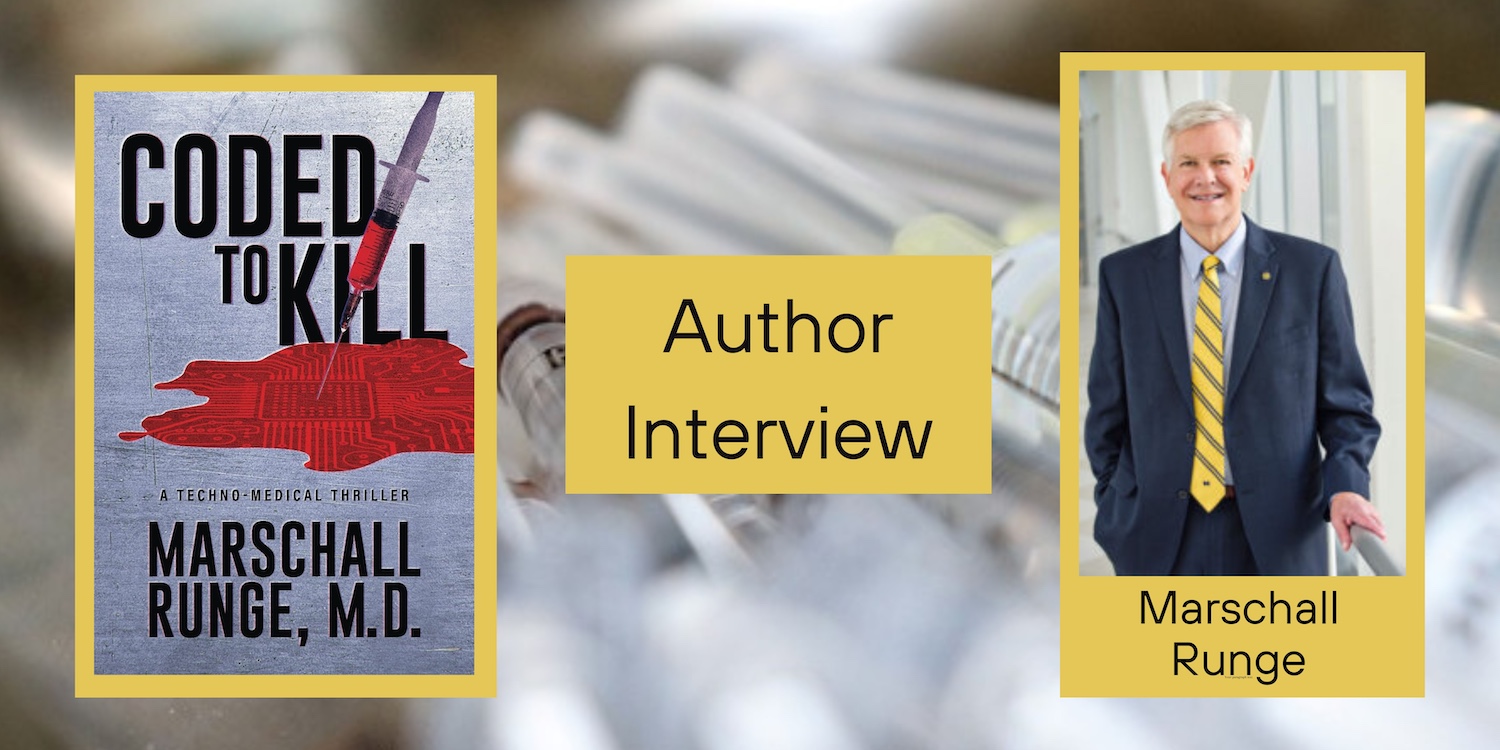Coded to Kill: A Techno-Medical Thriller by Marschall Runge M.D.
Author Interview + Book and Author Info!
Don’t miss any author interviews! Click the link here.
Coded to Kill: A Techno-Medial Thriller
 Is medicine’s greatest breakthrough also the world’s most efficient killing machine?
Is medicine’s greatest breakthrough also the world’s most efficient killing machine?
After a decade of development, Drexel Hospital’s cutting-edge Electronic Health Records system is about to become the national standard and revolutionize health care. Housing the real-time medical records of every American, the EHR system will enable doctors to access records with a keystroke and issue life-or-death medical orders with a finger swipe.
No one wants the EHR to succeed more than Hugh Torrence, a former NSA honcho who sees the system as a tool for unimaginable and unaccountable power. The only thing standing in his way is a loose-knit group of Drexel employees with conflicting agendas and questionable loyalties—including Dr. Mason Fischer, a physician with a taste for intrigue and a shadowy past; a street-wise techie named RT; and an internal medicine resident, Dr. Carrie Mumsford, the daughter of the hospital’s president.
While they search for answers, the suspicious patient deaths keep mounting as the target on their back grows larger.
To purchase Coded to Kill, click on the following links: Amazon & Barnes & Noble
Interview with Marschall Runge, M.D.
Coded to Kill centers on Hugh Torrence, formerly of the NSA. What would you like readers to know about him?
I don’t know what it says about me, but I had a lot of fun creating Hugh, who is the novel’s chief villain. The challenge was to not just depict an evil character – make no mistake, he is a stone-cold killer – but to render him in a way so that the reader also understands that Hugh sees himself as a hero.
In real life, it is not uncommon for the bad guys to think they’re good guys. Hugh is the brilliant son from a working-class family who found himself surrounded by people from elite backgrounds at the NSA who, in his mind, never had the nerve to do what needed to be done in a dangerous world. He views the revolutionary Electronic Health Records system developed at Drexel Memorial Hospital – which allows him to invisibly control the medical care received by every patient – as the most powerful means ever devised to “right the world.”
But for Torrence, it isn’t just a God complex, the EHR also provides him a unique, and opaque tool for retribution. If “doing good” means blackmailing and even murdering people he sees as a threat and who have wronged him in the past, so be it. I also tried to use this conflict – how the reader sees him and how he sees himself – as a symbol of our relationship to technology. It is almost always created by people with the best of intentions – it all upside in their book – when, in fact, there is almost always a darker side at play. Airplanes, for example, transport people and bombs; the splitting of the atom gave us a new source of energy and deadly weapons.
I tried to introduce a similar level of complexity with my main hero, Dr. Mason Fischer. Like me, he’s a cardiologist from Texas; unlike me, he was also a star football player for the Longhorns. Because of his rare mix of brawn and brains – and his desire to right the world following his mother’s death– Mason was recruited by a medical school Dean with military ties to perform special operations. Sent to Drexel with an elaborate cover story to look into some suspicious activity regarding the EHR, he constantly deceives those closest to him, including his budding love interest, Dr. Carrie Mumsford, to keep his mission secret.
Like Torrence, he feels he has good reason to lie. Unlike Torrence, he actually does!
Coded to Kill is a techno-thriller based (in part) on your own experience with health care innovations. How much of this novel is fact, how much is fiction, and how much is our possible future?
The premise – which, in a nutshell, is the promise and peril of medical technology – is real. But, of course, I took liberties because, hey, it’s fiction.
Coded To Kill began to take shape years ago through my work. I am a cardiologist and like many physicians, I found the transition to electronic health records to be problematic because they increased our paperwork and diverted some of our attention from patients. As I transitioned into more administrative work, first in North Carolina – the state where much of the action is set – and now in Michigan, I became aware of more systemic problems, especially how EHRs could lead to medical errors, physician burnout and weaken patient privacy.
For example, even before the pressures of COVID-19, the National Academy of Medicine found that burnout had reached “crisis levels” among physicians, nurses and even medical students. And, as our information has become digitized, hospitals have become chief targets of ransomware attacks from far-flung hackers. I wanted to highlight these very real problems in a fast-paced story aimed at a general audience.
With these ideas swirling in my mind, and having read too many thrillers, it occurred to me that “Coded To Kill” would be a fun and effective way to draw attention to these real – but also manageable – dangers.
Coded to Kill focuses on how the healthcare system can be used against us. What possible outcomes of that issue keeps you up at night?
As the CEO of Michigan Medicine, I devote increasing amounts of my time to protecting patient privacy and much of that towards making sure our IT experts have the means to keep up with the ever-expanding cyber-threats we see.
In Coded To Kill, the medical community is moving toward a central system that collects the electronic health record of every patient in the United States. This could happen one day because it would almost certainly improve patient outcomes. For example, the ability to compare your suspicious looking mole to millions of others – and how those responded to different therapies – would greatly enhance your dermatologist’s ability to determine next steps. Does the mole just need to be removed, or should your dermatologist be considering prescribing one of the powerful new biologic drugs that are highly effective, but also very expensive and carry with them unique potential side-effects.
A central repository would also help us identify and respond to new virus strains before they can become epidemic. It would have been a godsend during COVID, for example.
The problem is that all these uses for caregivers are opportunities for criminals and other bad actors. We will never completely eliminate these threats, but we can greatly reduce their impacts by addressing them head-on.
Tell us about your writing and publication process for Coded to Kill:
I began writing the book some years ago, usually at night, as a way to unwind. I knew next to nothing about the form and structure of the novel. I didn’t have an outline and would add characters based on people I worked with.
At one point I had written well-over 1,000 pages and no one (not even me) could discern a plot. Still, I believed I had the makings of a book, and I took on a writing partner, J. Peder Zane, to help whittle down and focus the story.
Once I got the book down to 500 pages, I began sending it out to agents. They provided excellent feedback – including that I should provide more information about the characters’ motivation and the call to trim it back even more.
After several more drafts, I was lucky enough to find a truly talented and energetic agent. Jonathan Bronitsky, who gave me another daunting task: Writing the book proposal. With his guidance, I learned a lot about the book business and how to summarize my lengthy thriller into a few quick sentences that would capture a publisher’s attention.
What can we find you doing when you aren’t reading or writing thrillers?
My “day job” is hectic, challenging and rewarding, all at the same time. And very time-consuming.
As my responsibilities have advanced, I’ve found I have to make choices about my time. I love spending time with my family – my wife, 5 adult children, their spouses, and my 5 grandchildren – and trying to get at least some exercise most days. We love spending time together, fishing and watching Netflix, in a rural area of my home state of Texas. At the end of Coded To Kill, Mason, Carrie and the other characters who helped them gather there as well.
What are you working on now?
Now that I have the writing bug, I have already outlined several more books in this series with many of the same characters. I really care about and enjoy spending time with them. I want to keep writing about them so I can continue to be in their presence.
I also think that I have just scratched the surface of who they are, their strengths, weaknesses, motivations and complexities in Coded To Kill. And as our health care system continues to embrace new life-saving and life-enhancing technologies including AI, unexpected threats will also emerge, which is the lifeblood of a good thriller.
Words of wisdom for Aspiring Authors:
Believe in yourself and listen to others. If you know you have a worthy story to tell, get it down on paper. If John Grisham and Stephen King faced massive rejection at first, you probably will too. But don’t forget you are writing for other people – your words have to resonate with them. Don’t be afraid to share your drafts with others; and let them know you want an honest response. Don’t take all their advice – no one knows your story and your characters better than you do – but take their ideas seriously and without ego. As a doctor, I tell people lots of things they do not want to hear, but it is all aimed at helping them. I try to see my readers in the same light.
Marschall Runge, M.D.
 Marschall S. Runge, M.D., Ph.D., is the executive vice president for Medical Affairs at the University of Michigan, dean of the Medical School, and CEO of Michigan Medicine.
Marschall S. Runge, M.D., Ph.D., is the executive vice president for Medical Affairs at the University of Michigan, dean of the Medical School, and CEO of Michigan Medicine.
He earned his doctorate in molecular biology at Vanderbilt University and his medical degree from Johns Hopkins School of Medicine, where he also completed a residency in internal medicine. He was a cardiology fellow at the Massachusetts General Hospital. He is the author of over 250 publications and holds five patents for novel approaches to health care.
As a Texas native who spent fifteen years in North Carolina and an avid thriller reader, Runge has experienced so many you-can’t-make-this-up events that his transition to fiction was inevitable.
Elena Taylor/Elena Hartwell
Header image from Pixabay



